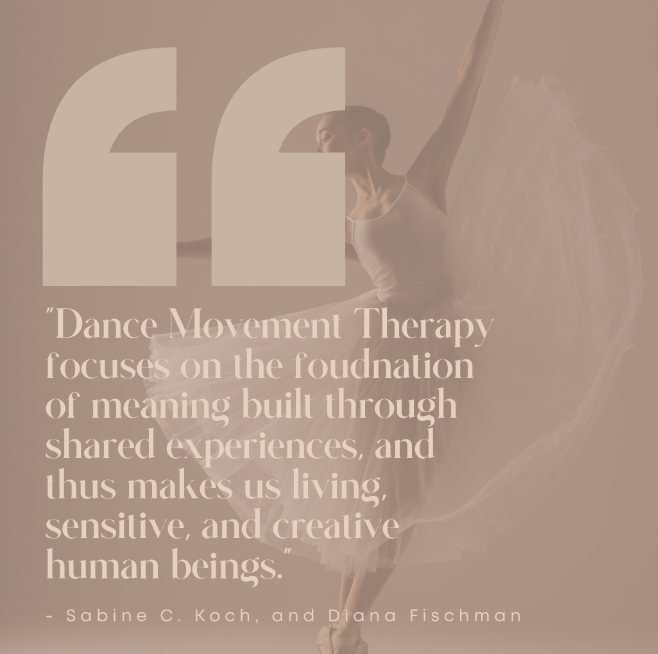Dance and Movement Therapy (DMT)
Discover Therapy Through The Art of Movement
Dance is a universal form of art that has been used for centuries to communicate, celebrate, and heal. Creative arts therapies combine art modalities and creative processes with talk therapy for the purpose of increasing self-awareness and facilitating healing. Movement therapy, also known as dance/movement therapy (DMT), is one of the many creative art therapies. Facilitated by a dance/movement therapist, DMT uses dance and movement to promote emotional, mental, and physical well-being. It can be an effective form of therapy for people of all ages, backgrounds, and abilities. In this blog, we will explore the benefits of dance and movement therapy and how it can help individuals improve their mental health and well-being.
What is Dance and Movement Therapy?
In dance and movement therapy, movement is used to help people explore emotions, enhance self-expression, and increase self-confidence. It can be a valuable tool for people who are struggling with depression, anxiety, or other issues related to their mental health. People can learn how to express their emotions in a secure, nonjudgmental setting through dance. Along with helping people improve their general physical and mental welfare, dance and movement therapy can also be utilized to assist and strengthen the social, cognitive, and cognitive-affective skills.
The foundation of DMT is based on the idea that the body and the mind are intertwined. An individual may experience bodily strain or pain as a result of stress or trauma. DMT uses dance and movement to relieve this tension and encourage recovery. Individuals are able to discover and express feelings that may be challenging to put into words through movement and dance.
A therapist may employ a range of methods, including guided movements or improvisation, throughout a session to assist clients in exploring their feelings. To encourage individuals connect with their feelings and express themselves via movement, the therapist may also incorporate music or other stimuli in the sessions. Studies have shown that individuals are better able to understand their emotions and how they interact with their bodies by using these strategies. The objective of DMT therapy sessions is to give the clients a chance to express themselves freely.
How does Dance Therapy differ from Regular Dancing?
Dance therapy is a form of therapeutic treatment that uses movement and dance to support emotional, cognitive, and physical healing. Unlike regular dancing, dance therapy is led by a trained therapist who uses specific movements and techniques to help clients express themselves and work through emotional or psychological issues. While regular dancing can be fun and enjoyable, dance therapy is a form of clinical therapy that is designed to support mental health and wellness.
Different techniques of DMT
Mirroring, also known as the Mirror Game, is a commonly used technique in DMT where a therapist or a client reflects back the movements and gestures of their partner. This technique helps to establish a sense of connection and empathy between the participants and can be used to build trust and establish rapport.
Movement metaphors is another technique that involves the use of non-verbal movement to express emotions, thoughts or experiences. It involves using the body to create metaphors that can help individuals gain insight into their feelings or experiences. This technique can be particularly helpful for individuals who have difficulty expressing themselves verbally or who have experienced trauma. Movement metaphors can be used in a variety of ways - for example, a therapist may ask an individual to explore the metaphor of "walking through a dark tunnel" to represent their journey through a difficult time in their life. The individual may use movement to express their feelings of fear, uncertainty, and hope as they navigate the metaphorical tunnel.
Jumping Rhythms technique involves using various types of jumps and rhythms to promote physical and emotional expression, release tension, and increase energy and vitality. It is often used as a tool for individuals to connect with their bodies and emotions, while also promoting a sense of playfulness and creativity.
DMT can help individuals acquire some important skills during the therapy process. These include greater self-awareness, improved emotional regulation, increased confidence and self-esteem, better body awareness and coordination, improved communication and social skills, and a deeper connection to one's own creativity and expression.
What kind of issues can DMT help with?
It is frequently employed to address a variety of social, cognitive, emotional, and physical issues, including:
Physical Issues
Childhood obesity
Arthritis
Hypertension
Cardiovascular disease
Mental Health Issues
Poor self-esteem
Cognitive Issues
Social Issues
Social interaction
Benefits of dance and movement therapy
Some of the benefits of DMT include:
Improved emotional well-being: DMT can help individuals process and express emotions that may be difficult to articulate through words.
Increased self-awareness: By becoming more attuned to their body and movements, individuals can develop a greater understanding of themselves.
Enhanced physical health: DMT can help to release physical tension and promote relaxation, which can lead to improved physical health.
Increased social connection: DMT can be done in a group setting, which can help individuals to connect with others and develop a sense of community.
Improved self-esteem: Through movement and dance, individuals can develop a sense of mastery and accomplishment, which can improve their self-esteem.
Conclusion
In conclusion, dance and movement therapy can be used in a creative and fun way to increase overall health and well-being. It can be used to treat and manage a range of mental health issues and is a safe and effective method of therapy. Dance and movement therapy can aid people in understanding themselves better and enhancing their general quality of life by employing movement to encourage emotional expression and self-awareness. Contact us for a free consultation if you'd like to find out more about dance and movement therapy.

